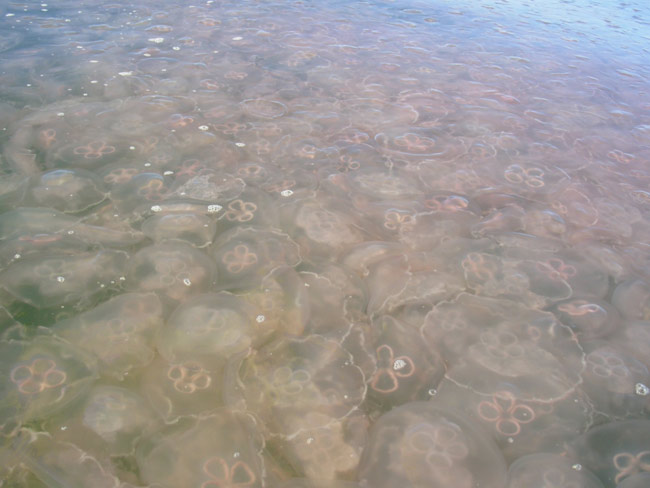The Truth Behind Global Jellyfish Swarms

This Behind the Scenes article was provided to LiveScience in partnership with the National Science Foundation.
Large swarms of jellyfish and other gelatinous animals — sometimes covering hundreds of square miles of ocean — have recently been reported in many of the world's prime vacation and fishing destinations.
In this interview with Lily Whiteman of the National Science Foundation, renowned "jellyologist" Monty Graham of the Dauphin Island Sea Lab in Alabama discusses the origins and impacts of such swarms. (Note: Jellyfish and other gelatinous animals are called "jellies" here.)
1. What types of damage have jelly swarms caused?
"Damage" can be seen as either economic or environmental. Recent examples of jelly swarms that have created such problems include:
- Tourism in Australia where deadly box jellies live and in the Mediterranean where stinging jellyfish closed down many beaches during the summer of 2008.
- Many important fisheries, including the Gulf of Mexico, where jellies regularly clog nets, fowl fishing gear or prey on eggs and larvae of fish.
- Aquaculture operations are often affected. One particular example was in 2007 when an extraordinarily large swarm of jellyfish virtually wiped out a salmon farm off northern Ireland.
- Seafloor diamond operations off the coast of Namibia, where jellies have clogged vacuum pipes.
- Nuclear power plants in many locations. Recently, in November 2008, a jelly swarm clogged intake pipes at the Diablo Canyon power plant in California, and thereby caused a temporary plant shut-down.
2. How densely are jellies packed together in swarms?
In most cases, a dense swarm would be a few animals in one cubic meter of water. However, in extreme cases, there can be more jellies than water. Such swarms may cover a hundred miles of more of coastline at a time.
Get the world’s most fascinating discoveries delivered straight to your inbox.
3. Are jelly swarms natural phenomena?
Yes. Jellies have likely swum and swarmed in our seas for over 600 million years. When conditions are right, jelly swarms can form quickly. They appear to do this for sexual reproduction. Since males need to release gametes (sperm) into the water, they need to be very close to females. Therefore swarming behavior is just a way for them to be close to each other.
4. Are jelly populations increasing?
In some locations, jelly populations are increasing. But such increases are regional in nature; we do not have evidence that there are "global" increases due to global influences, but evidence is mounting that climate change may have an effect.
5. Are human-caused environmental problems promoting population explosions of jellies?
Various types of environmental problems may promote the formation of jelly swarms. These problems include pollution, the overharvesting of fish, the introduction of non-native jelly species into new habitats, the addition of artificial substrate (like fishing reefs, and various offshore platforms) in the ocean and climate change.
6. How may climate change promote population explosions of jellies?
Higher water temperatures may speed jelly reproduction as well as extend the growing season for jellies; a longer reproduction season could result in more jellies. Climate change may also increase the amount of food available for jellies.
Also, climate change may change ocean currents. Changed currents may transport jellies — which drift with currents — into new habitats.
Because climate change appears to be a world-wide phenomenon, climate change may have worldwide impacts on jellies. But we really don’t know yet what the details regarding interactions between climate change and jelly populations.
7. In light of the abundance of jellies, why don’t we know more about them?
Marine ecologists have traditionally regarded jellies as mere nuisances that interfered with studies of truly important creatures. Because of such attitudes, ecologists have traditionally gone to great lengths to avoid jellies, rather than to study them. In fact, in the past, when scientists accidentally caught jellies in their research nets, they often did horrific things to jellies — like pouring bleach over them in order to dissolve them away without destroying the hard critters that they really wanted to study.
Because jellies have traditionally been understudied, we don’t have many accurate long-term records of their population sizes. Therefore, in many places, we can’t yet say for sure whether or how much jelly population sizes may be changing.
8. Are jellies finally getting the respect they deserve?
Appreciation of the ecological importance of jellies has steadily grown since the 1980s, when jelly populations exploded in several ecosystems, including the Black Sea. More scientists are now studying jellies in more locations than ever before.
9. Why are jellies particularly difficult to study?
Jellies are fragile and so they are often destroyed when we try to collect them in nets. Also, jellies are difficult to preserve because their bodies are destroyed by many types of preservatives. Plus, many types of jellies are too big or too small to be raised and studied in captivity.
10. Have you ever been badly stung by jellies while researching them?
Yes, but not more than an uncomfortable sting. I do have colleagues that have been hospitalized while studying jellies, though.
11. In light of the fact that jellies are difficult to study and the ocean is so complex, how can scientists identify the individual impacts of each type of environmental disturbance on jelly populations?
By developing computer models of marine ecosystems. One of my main activities now is to help build such models, and then manipulate various factors in these models — such as water temperature or salinity and the size of fish harvests — in order to identify their relative influences on jelly populations.
12. If some places have too many jellies, why don’t people just eat them?
Some jellies are eaten by humans and have long been considered a delicacy in some Asian countries. In addition, processed jellies are sold in some Asian food stores in the U.S.
13. As long-lived, hardy and often abundant creatures, are jellies "the cockroaches of the sea?"
Absolutely not! Jellies are much better than cockroaches! Jellies represent among the oldest living animals on Earth and if the past is prologue, these highly successful creatures will continue to thrive even under the changing conditions of today's oceans. I have said before that most likely cockroaches will be long gone when the last jelly swims in a lonely sea.
- Gallery: Rich Life Under the Sea
- 10 Species You Can Kiss Good-bye
- Small Sea Monsters
For more information: Visit the National Science Foundation’s special online report on jelly swarms, "Jellyfish Gone Wild: Environmental Change and Jellyfish Swarms" at this link. And a video of Monty Graham discussing jellyfish swarms is included in this report.


